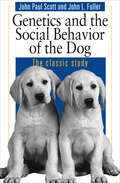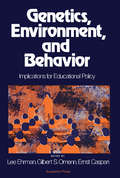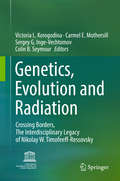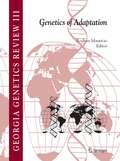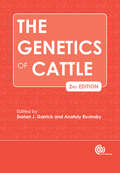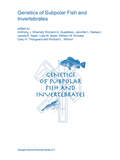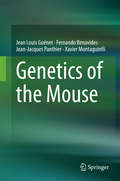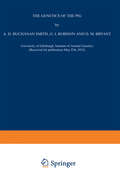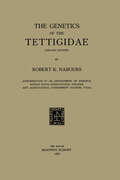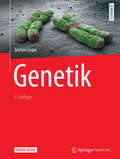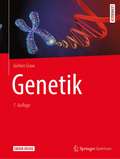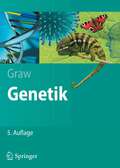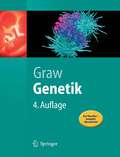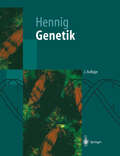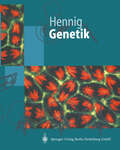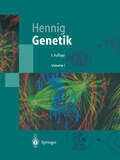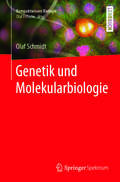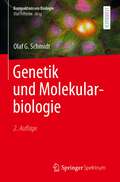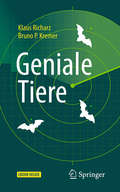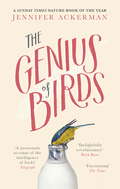- Table View
- List View
Genetics and the Social Behaviour of the Dog
by John Paul Scott John L. FullerThe classic study of dog behavior gathered into one volume. Based on twenty years of research at the Jackson Laboratory, this is the single most important and comprehensive reference work on the behavior of dogs ever complied. "Genetics and the Social Behavior of the Dog is one of the most important texts on canine behavior published to date. Anyone interested in breeding, training, or canine behavior must own this book."—Wayne Hunthausen, D.V.M., Director of Animal Behavior Consultations "This pioneering research on dog behavioral genetics is a timeless classic for all serious students of ethology and canine behavior."—Dr. Michael Fox, Senior Advisor to the President, The Humane Society of the United States "A major authoritative work. . . . Immensely rewarding reading for anyone concerned with dog-breeding."—Times Literary Supplement "The last comprehensive study [of dog behavior] was concluded more than thirty years ago, when John Paul Scott and John L. Fuller published their seminal work Genetics and the Social Behavior of the Dog."—Mark Derr, The Atlantic Monthly "Genetics and the Social Behavior of the Dog is essential reading for anyone involved in the breeding of dogs. No breeder can afford to ignore the principles of proper socialization first discovered and articulated in this landmark study."-The Monks of New Skete, authors of How to Be Your Dog's Best Friend and the video series Raising Your Dog with the Monks of New Skete.
Genetics and the Social Behaviour of the Dog
by John Paul Scott John L. FullerThe classic study of dog behavior gathered into one volume. Based on twenty years of research at the Jackson Laboratory, this is the single most important and comprehensive reference work on the behavior of dogs ever complied. "Genetics and the Social Behavior of the Dog is one of the most important texts on canine behavior published to date. Anyone interested in breeding, training, or canine behavior must own this book."—Wayne Hunthausen, D.V.M., Director of Animal Behavior Consultations "This pioneering research on dog behavioral genetics is a timeless classic for all serious students of ethology and canine behavior."—Dr. Michael Fox, Senior Advisor to the President, The Humane Society of the United States "A major authoritative work. . . . Immensely rewarding reading for anyone concerned with dog-breeding."—Times Literary Supplement "The last comprehensive study [of dog behavior] was concluded more than thirty years ago, when John Paul Scott and John L. Fuller published their seminal work Genetics and the Social Behavior of the Dog."—Mark Derr, The Atlantic Monthly "Genetics and the Social Behavior of the Dog is essential reading for anyone involved in the breeding of dogs. No breeder can afford to ignore the principles of proper socialization first discovered and articulated in this landmark study."-The Monks of New Skete, authors of How to Be Your Dog's Best Friend and the video series Raising Your Dog with the Monks of New Skete.
Genetics, Environment, and Behavior: Implications for Educational Policy
by Lee Ehrman Gilbert S. Omenn Ernst CaspariGenetics, Environment, and Behavior: Implications for Educational Policy is a collection of papers from the "Genetic Endowment and Environment in the Determination of Behavior" workshop in New York in October 1971. The book discusses the relationships between genetic characteristics and behavior as being significant in understanding human behavior and learning. The text also considers the different approaches made by geneticists and psychologists on this subject. Several papers review, in terms of both quantitative and qualitative analysis, the role that genetics and the environment play in determining behavior. One paper explains the possible role of genetic determination in behaviors as found in mice and men that show high probabilities of heritabilities. Another paper tackles biochemical genetics and explains the evolution of human behavior by addressing the enzyme variations in human brains and the role of language and culture. The book also cites gene-environment interactions and the variability that can be found in behavior with references to the works of Ginsburg (1967) and Vale and Vale (1969). One paper comments on the future of human behavior genetics, highlighting the distinction between what should happen and what most probably will happen. This text is suitable for sociologists, behavioral scientists, geneticists, educators, and students in psychology, psychiatry, and related branches of medicine.
Genetics, Evolution and Radiation: Crossing Borders, The Interdisciplinary Legacy of Nikolay W. Timofeeff-Ressovsky
by Victoria L. Korogodina Carmel E Mothersill Sergey G. Inge-Vechtomov Colin B. SeymourThis book is dedicated to the great scientist and outstanding individual Nikolay Wladimirovich Timofeeff-Ressovsky. The book brings together a number of brief stories/essays about Timofeeff-Ressovsky including “Stories told by himself”, and scientific chapters addressing his major research areas: genetics, radiobiology, radiation ecology and epidemiology, and evolution. Timofeeff-Ressovsky contributed to several fields of biology and established new directions of scientific research. He often repeated the phrase, which would later become famous: “Science should not be approached with the ferocity of wild animals”. In keeping with that philosophy, the issues discussed here are still open. Each scientific part starts with a current review; the chapters present leading scientific schools and views. The main theme discussed in the genetics part is mutation variability in the context of linear (replication, transcription, translation) and conformational template processes, and its dependence on phylogenetic group. In turn, the radiobiology chapters focus on the reorganization of DNA, cell, and population variability under low-dose irradiation, sparking indirect processes and adaptive response. The radiation ecology and epidemiology parts present data on the consequences of nuclear plants and related accidents for ecological systems and human beings. Here some approaches to estimating radiation risks are also offered. Evolution laws are demonstrated in the genomic universe, plant-microbe symbiosis, stabilizing and destabilizing (directional) selection. The last essay demonstrates the principles of organization operating in local animal populations, which are approached as social organisms of complex systemic nature.The chapter 'Radiation-Induced Aging and Genetic Instability of Mesenchymal Stem Cells: An Issue for Late Health Effects?' is available open access under a CC BY 4.0 license.
Genetics of Adaptation (Georgia Genetics Review #3)
by Rodney MauricioAn enduring controversy in evolutionary biology is the genetic basis of adaptation. Darwin emphasized "many slight differences" as the ultimate source of variation to be acted upon by natural selection. In the early 1900’s, this view was opposed by "Mendelian geneticists", who emphasized the importance of "macromutations" in evolution. The Modern Synthesis resolved this controversy, concluding that mutations in genes of very small effect were responsible for adaptive evolution. A decade ago, Allen Orr and Jerry Coyne reexamined the evidence for this neo-Darwinian view and found that both the theoretical and empirical basis for it were weak. Orr and Coyne encouraged evolutionary biologists to reexamine this neglected question: what is the genetic basis of adaptive evolution? In this volume, a new generation of biologists have taken up this challenge. Using advances in both molecular genetic and statistical techniques, evolutionary geneticists have made considerable progress in this emerging field. In this volume, a diversity of examples from plant and animal studies provides valuable information for those interested in the genetics and evolution of complex traits.
Genetics of Cattle, The
by Dorian J. Garrick Anatoly RuvinskySince the time of domestication more than 10,000 years ago, cattle have played an increasingly crucial role in the development of human civilizations. Progress has been quite remarkable since the turn of the century; the sequencing of the bovine genome in 2009 launched new avenues for furthering our understanding of theoretical and practical aspects of cattle genetics. Covering a vast array of questions, this book reviews major topics from molecular and developmental genetics, disease resistance and immunogenetics to genetic improvement of dairy and beef breeds, addressing all current problems in the field. This second edition includes a new team of authors and completely new chapters on the genetics of fat production, nutrition, feed intake and efficiency, growth and body composition. Fully updated throughout, it provides a valuable resource on cattle genetics for researchers, breeders, veterinarians and postgraduate students.
Genetics of Subpolar Fish and Invertebrates (Developments in Environmental Biology of Fishes #23)
by Anthony J. Gharrett Richard G. Gustafson Jennifer L. Nielsen James E. Seeb Lisa W. Seeb William W. Smoker Gary H. Thorgaard Richard L. WilmotFisheries genetics researchers will find invaluable the thirty-eight peer-reviewed contributions in this book, presented at the 20th Lowell Wakefield Fisheries Symposium "Genetics of Subpolar Fish and Invertebrates," held in May 2002 in Juneau, Alaska. Looming over concerns of lost fisheries stocks and persistent erosion of genetic variability are predictions of global warming, which may further tax genetic resources. One consequence is an increased reliance on genetic applications to many aspects of fisheries management, aquaculture, and conservation. The contributions in this book are important to modern fisheries science and genetics, and illustrate the evolution of the field over the past decade. The improved technology provides tools to address increasingly complicated problems in traditional applications and ecological and behavioral studies. The union between molecular and quantitative genetics, where many of the major questions about population structure and evolution remain unanswered, will also benefit from the new technologies.
Genetics of the Mouse
by Jean Louis Guénet Fernando Benavides Jean-Jacques Panthier Xavier MontagutelliThis book, written by experienced geneticists, covers topics ranging from the natural history of the mouse species, its handling and reproduction in the laboratory, and its classical genetics and cytogenetics, to modern issues including the analysis of the transcriptome, the parental imprinting and X-chromosome inactivation. The strategies for creating all sorts of mutations, either by genetic engineering or by using mutagens, are also reviewed and discussed in detail. Finally, a last chapter outlines the methodology used for the analysis of complex or quantitative traits. The authors also discuss the importance of accurate phenotyping, which is now performed in the mouse clinics established worldwide and identify the limits of the mouse model, which under certain circumstances can fail to present the phenotype expected from the cognate condition in the human model. For each chapter an up-to-date list of pertinent references is provided. In short, this book offers an essential resource for all scientists who use or plan to use mice in their research.
Genetik: Die Abbildungen Des Buches (Springer-Lehrbuch)
by Jochen GrawVon Mendel bis zu Genomforschung und Gentechnologie reicht dieses Standardwerk der Genetik. In der 6. Auflage um ein Kapitel zur Epigenetik und um Fragen und Antworten ergänzt sowie aktualisiert, bietet dieses Lehrbuch eine umfassende Darstellung der klassischen und der molekularen Genetik. Cytogenetik, Entwicklungsgenetik, Humangenetik und Anthropologie sowie Neuro- und Verhaltensgenetik sind weitere wichtige Inhalte. Technikboxen bereichern das umfassende Themen- und Methodenspektrum des Buches. Dieses Buch vermittelt genetisches Grundlagenwissen für das gesamte Studium. Dabei unterstützen zahlreiche hervorgehobene Lernhilfen und Beispiele aus allen Bereichen der Genetik sowie farbige Abbildungen.
Genetik
by Jochen GrawVon Mendel bis zu Genomforschung und Gentechnologie reicht dieses Standardwerk der Genetik. Es ist klar strukturiert und bietet eine umfassende Darstellung der klassischen und der molekularen Genetik. Cytogenetik, Entwicklungsgenetik, Humangenetik und Anthropologie sowie Neuro- und Verhaltensgenetik sind weitere wichtige Inhalte. Komplexe Sachverhalte werden verständlich und auf dem aktuellen wissenschaftlichen Stand dargestellt. Technikboxen bereichern das umfassende Themen- und Methodenspektrum. Dieses Buch vermittelt genetisches Grundlagenwissen für das gesamte Studium. Dabei unterstützen zahlreiche hervorgehobene Lernhilfen und Beispiele aus allen Bereichen der Genetik, ansprechende, farbige Abbildungen sowie Übungsfragen. Die 7. Auflage wurde gründlich überarbeitet und aktualisiert sowie mit Links zu erklärenden Videos zu besonderen Aspekten des jeweiligen Kapitels ergänzt.
Genetik (Springer-Lehrbuch)
by Jochen GrawDer Band bietet eine umfassende und präzise Darstellung der klassischen wie der modernen Genetik: Entwicklungsbiologie und –genetik, Humangenetik, Neuro- und Verhaltensgenetik sowie Chromosomenforschung. Für die 5. Auflage wurde das Lehrbuch grundlegend überarbeitet und aktualisiert. Es beinhaltet das Grundlagenwissen der Genetik für das gesamte Studium. Die Inhalte werden durch zahlreiche Lernhilfen und Beispiele aus allen Bereichen der Genetik vermittelt. Alle Abbildungen sind im Internet frei verfügbar.
Genetik (Springer-Lehrbuch)
by Jochen GrawGrundlegend überarbeitet und aktualisiert bietet dieses Lehrbuch in der 4. Auflage eine umfassende Darstellung der klassischen und der molekularen Genetik, von Mendel bis zu Genomforschung und Gentechnologie.
Genetik (Springer-Lehrbuch)
by Wolfgang HennigAktuell überarbeitet und erweitert bietet der "Hennig" eine umfassende Darstellung der klassischen und molekularen Genetik von den Mendelschen Regeln über die Chromosomenforschung bis hin zur Entwicklungsbiologie, Humangenetik und Gentechnologie: Genetisches Grundlagenwissen für das gesamte Studium. Ein neues Kapitel zum Thema Human Genom Forschung erweitert das aktuelle Themen- und Methodenspektrum des Buches. Die Kapitel zu Humangenetik und Gentechnologie wurden mit Hinblick auf den aktuellen Wissensstand überarbeitet und ergänzt. Die Inhalte werden durch zahlreiche hervorgehobene Lernhilfen und Beispiele aus allen Bereichen der Genetik optimal vermittelt. Ausführliche Literaturangaben ermöglichen den Zugang auch zu Originalarbeiten.
Genetik (Springer-Lehrbuch)
by Wolfgang HennigWas ist Genetik? Wer in die Thematik einsteigen möchte, findet hier die Antwort. Ausführlich und aktuell werden Grundlagen und Zusammenhänge, Fakten und Trends beschrieben. Verständlich und anschaulich sind die Informationen zusammengestellt. Durchgehend vierfarbige, lerngerecht gestaltete Seiten mit zahlreichen Abbildungen bieten nicht nur fundiertes Wissen, sondern reines Lesevergnügen. Concise text: Was ist Genetik? Ausführlich und aktuell werden Grundlagen und Zusammenhänge, Fakten und Trends beschrieben. Die anschauliche Darstellung bietet nicht nur fundiertes Wissen, sondern reines Lesevergnügen.
Genetik und Molekularbiologie (Kompaktwissen Biologie)
by Martin Lay Olaf SchmidtDie Reihe Kompaktwissen präsentiert in klarer, prägnanter Darstellung die Inhalte biologischer Fachgebiete. Ohne unnötigen Ballast und im richtigen Kontext erläutert jeder Band verständlich die Fakten, Zusammenhänge und Prinzipien eines Teilgebiets der Lebenswissenschaften. Damit eignet sich die Reihe besonders… zur Nachbereitung von Vorlesungen und Seminaren … zur Vorbereitung auf Prüfungen… zum Nachschlagen während des späteren Studiums oder im Berufsleben. Das Wichtigste zur Genetik und ihrer Molekularbiologie von Pro- und EukaryotenDas gesamte Wissen zur Genetik für die Prüfungen bis zum Bachelor oder ersten Staatsexamen in kompakter Form: Das genetische Material Organisation des Erbgutes DNA-Replikation Transkription und Translation bei Bakterien, Archaeen und Eukaryoten Regulation der Genexpression bei Prokaryoten Formale Genetik, Klassische Genetik Rekombination, Variabilität Konjugation, Transduktion, Transformation bei Bakterien Mutationen DNA-Reparaturmechanismen Humangenetik Immun- und Entwicklungsgenetik Genomik Methoden: von DNA-Isolierung bis Genome editing Modellorganismen
Genetik und Molekularbiologie (Kompaktwissen Biologie)
by Olaf G. SchmidtDer Espresso unter den LehrbüchernKompaktwissen Genetik und Molekularbiologie präsentiert die Inhalte in klarer, prägnanter Darstellung. Ohne unnötigen Ballast und im richtigen Kontext erläutert der Band verständlich die Fakten, Zusammenhänge und Prinzipien dieses wichtigen Teilgebiets der Lebenswissenschaften. Damit eignet er sich besonders… zur Nachbereitung von Vorlesungen und Seminaren … zur Vorbereitung auf Prüfungen… zum Nachschlagen während des späteren Studiums oder im Berufsleben. Das Wichtigste zur Genetik und ihrer Molekularbiologie von Pro- und Eukaryoten Das gesamte Wissen zur Genetik für die Prüfungen bis zum Bachelor oder ersten Staatsexamen in kompakter Form:Das genetische MaterialOrganisation des ErbgutsDNA-ReplikationTranskription und Translation bei Bakterien, Archaeen und EukaryotenRegulation der Genexpression bei ProkaryotenRegulation der Genexpression bei EukaryotenFormale Genetik, Klassische GenetikRekombination, VariabilitätKonjugation, Transduktion, Transformation bei BakterienMutationenDNA-ReparaturmechanismenHumangenetikImmun- und EntwicklungsgenetikGenomikMethoden: von DNA-Isolierung bis Genome Editing und Organ-ChipsModellorganismenDie zweite Auflage wurde durchgehend überarbeitet und um aktuelle Inhalte ergänzt. Erweitert wurden vor allem die Darstellungen zur Architektur des Genoms, seiner Kontrolle und Regulation und die Bedeutung epigenetischer Vorgänge.
Geniale Tiere: Anekdotisches, Bewundernswertes und Erstaunliches aus allen Bereichen unserer Fauna
by Klaus Richarz Bruno P. KremerVom mikroskopisch kleinen Lebewesen bis zum großen Vierbeiner versetzen uns die meisten Tiere in Erstaunen: Sie können tiefer tauchen, schneller schwimmen, besser laufen oder gar ausdauernd fliegen – physische Leistungsmerkmale, die uns in dieser Perfektion weitgehend fehlen. Noch erstaunlicher sind ihre sensorischen Fähigkeiten: Wer kann schon mit den Ohren sehen oder seine Auserwählte aus einer Distanz von rund 10 km nur mit dem Geruchssinn wahrnehmen? Dieses Buch berichtet über bewundernswerte Eigenheiten und Fähigkeiten von Tieren aller größeren Verwandtschaftsgruppen: Staunen Sie über das reiche Leben zwischen den Sandkörnern des Strandes. Wundern Sie sich über Bienen, die in leeren Schneckenhäusern wohnen. Oder haben Sie je von Tieren gehört, die mit den Füßen fischen? Weitere spannende Themen sind lärmende Meeresfische, dreiäugige Echsen, giftige Vögel und Fledermäuse im Rotlichtmilieu. Mit diesem Wissen wird Ihnen der Gesprächsstoff bei keiner Gelegenheit ausgehen.
Genie and Teeny 2-book Collection Volume 1 (Genie and Teeny)
by Steven LentonMeet Grant the genie, and his best friend – the puppy, Teeny… The first two books in a series of magical adventures from the renowned illustrator, Steven Lenton, winner of Waterstones Picture Book of the Month and the Times Children’s Book of the Week.
Genie and Teeny 2-book Collection Volume 2 (Genie and Teeny)
by Steven LentonGrant the genie, and his best friend – the puppy, Teeny, are back . . . The second two books in a series of magical adventures from the renowned illustrator, Steven Lenton, winner of Waterstones Picture Book of the Month and The Times Children’s Book of the Week.
Genie and Teeny: Wishful Thinking (Genie and Teeny #2)
by Steven LentonMeet Grant the genie, and his best friend – the puppy, Teeny… The second in a series of magical adventures from the renowned illustrator, Steven Lenton, winner of Waterstones Picture Book of the Month and the Times Children’s Book of the Week.
Genie and Teeny: The Wishing Well (Genie and Teeny #3)
by Steven LentonMeet Grant the genie, and his best friend – the puppy, Teeny… The third in a series of magical adventures from the renowned illustrator, Steven Lenton, winner of Waterstones Picture Book of the Month and the Times Children’s Book of the Week.
The Genius of Birds: The Intelligent Life of Birds
by Jennifer AckermanBirds are astonishingly intelligent creatures. In fact, according to revolutionary new research, some birds rival primates and even humans in their remarkable forms of intelligence. Like humans, many birds have enormous brains relative to their size. Although small, bird brains are packed with neurons that allow them to punch well above their weight.In The Genius of Birds, acclaimed author Jennifer Ackerman explores the newly discovered brilliance of birds and how it came about. As she travels around the world to the most cutting-edge frontiers of research - the distant laboratories of Barbados and New Caledonia, the great tit communities of the United Kingdom and the bowerbird habitats of Australia, the ravaged mid-Atlantic coast after Hurricane Sandy and the warming mountains of central Virginia and the western states - Ackerman not only tells the story of the recently uncovered genius of birds but also delves deeply into the latest findings about the bird brain itself that are revolutionizing our view of what it means to be intelligent.Consider, as Ackerman does, the Clark's nutcracker, a bird that can hide as many as 30,000 seeds over dozens of square miles and remember where it put them several months later; the mockingbirds and thrashers, species that can store 200 to 2,000 different songs in a brain a thousand times smaller than ours; the well-known pigeon, which knows where it's going, even thousands of miles from familiar territory; and the New Caledonian crow, an impressive bird that makes its own tools.But beyond highlighting how birds use their unique genius in technical ways, Ackerman points out the impressive social smarts of birds. They deceive and manipulate. They eavesdrop. They display a strong sense of fairness. They give gifts. They play keep-away and tug-of-war. They tease. They share. They cultivate social networks. They vie for status. They kiss to console one another. They teach their young. They blackmail their parents. They alert one another to danger. They summon witnesses to the death of a peer. They may even grieve.This elegant scientific investigation and travelogue weaves personal anecdotes with fascinating science. Ackerman delivers an extraordinary story that will both give readers a new appreciation for the exceptional talents of birds and let them discover what birds can reveal about our changing world.
